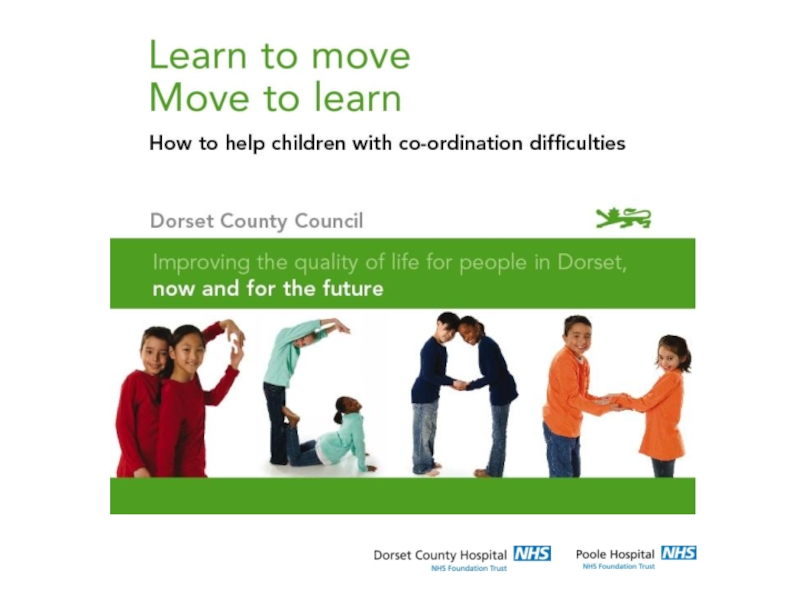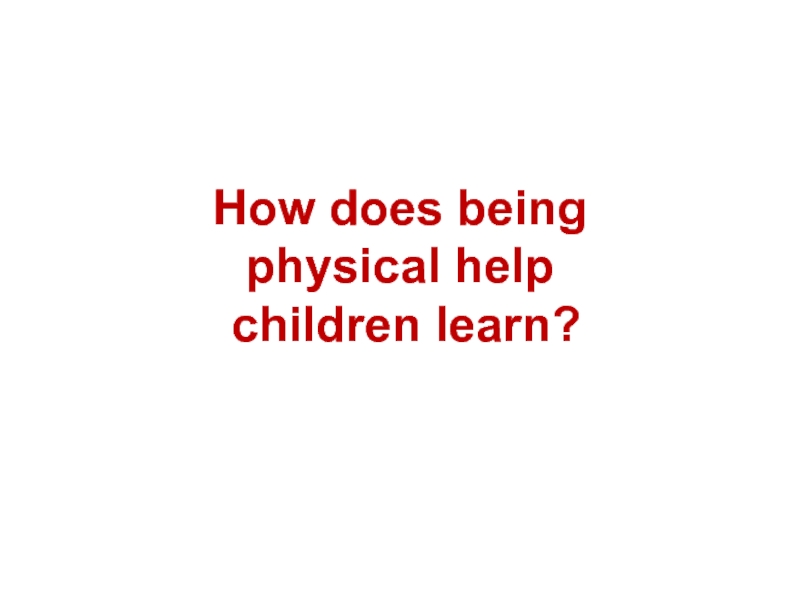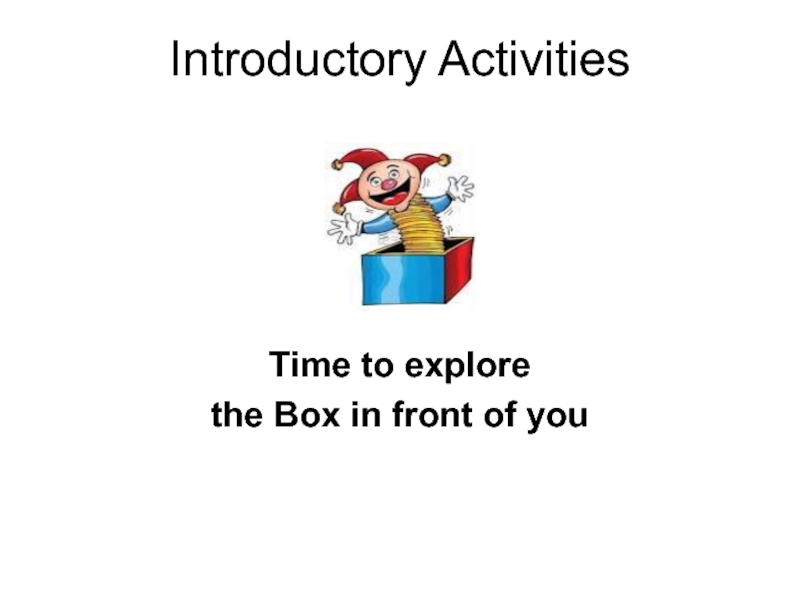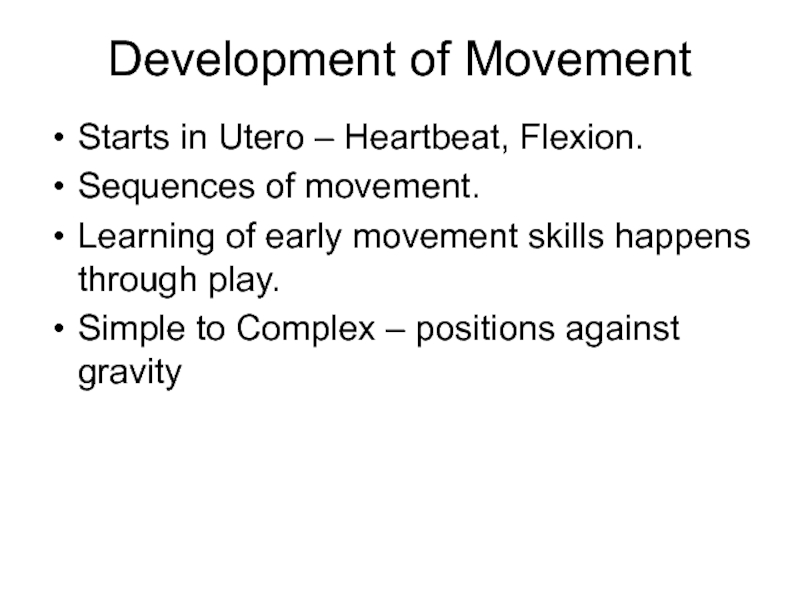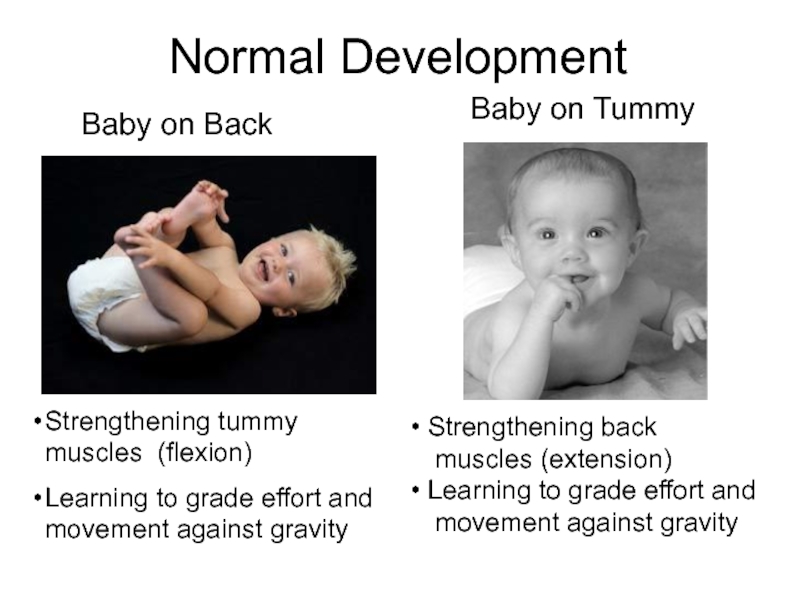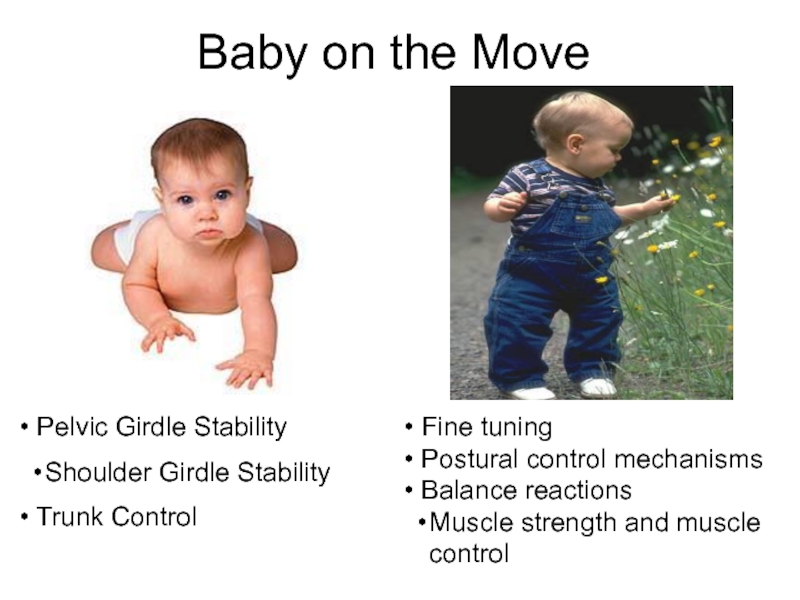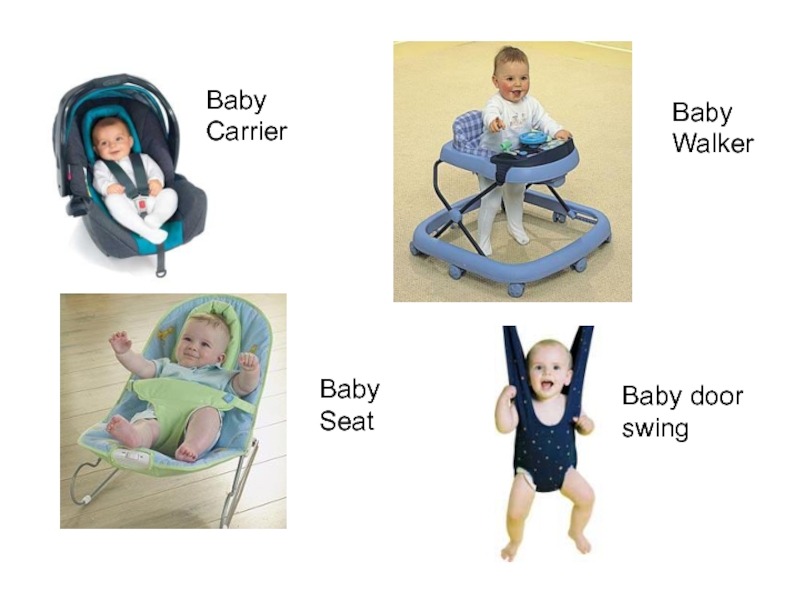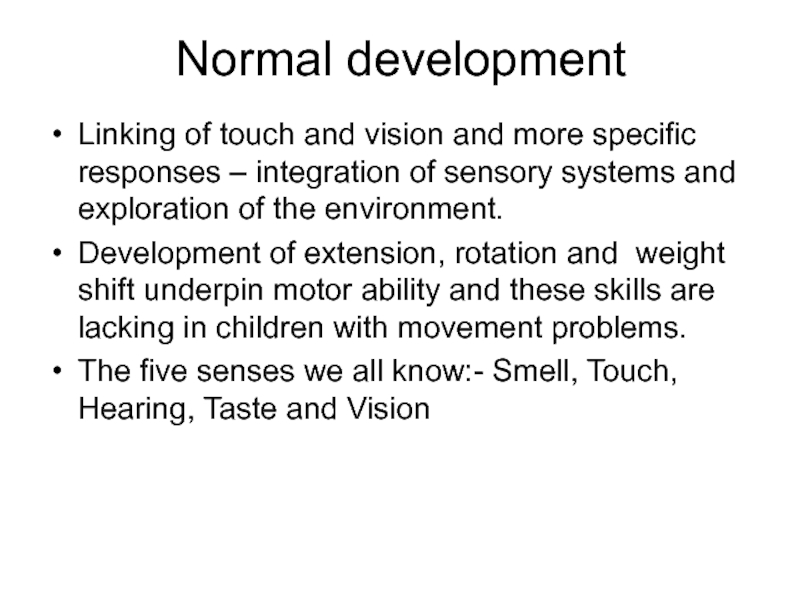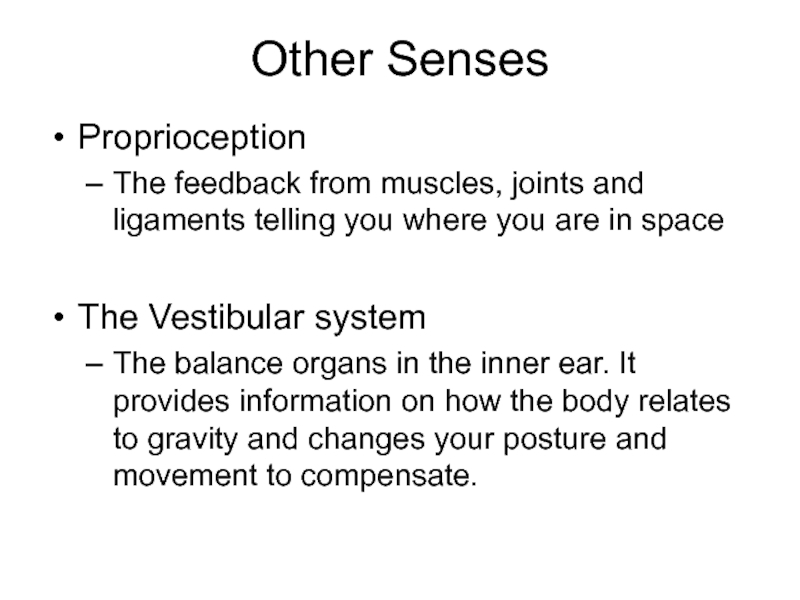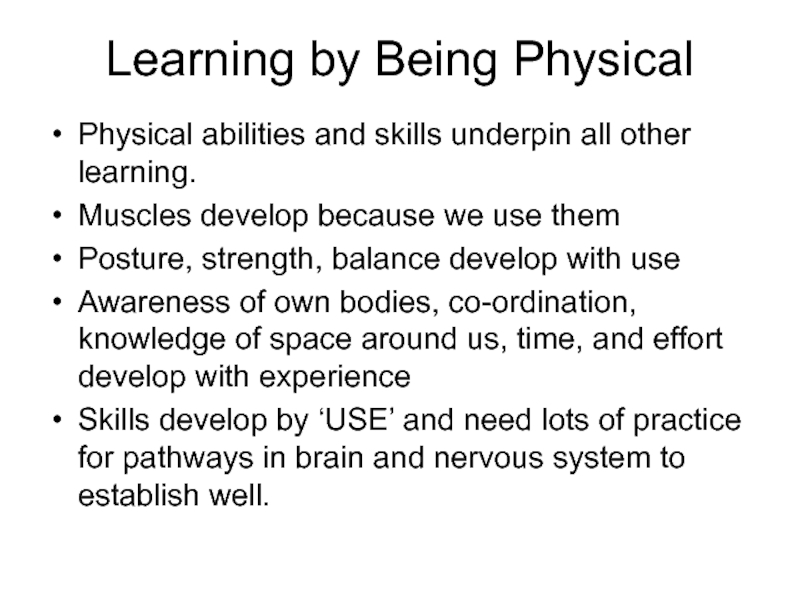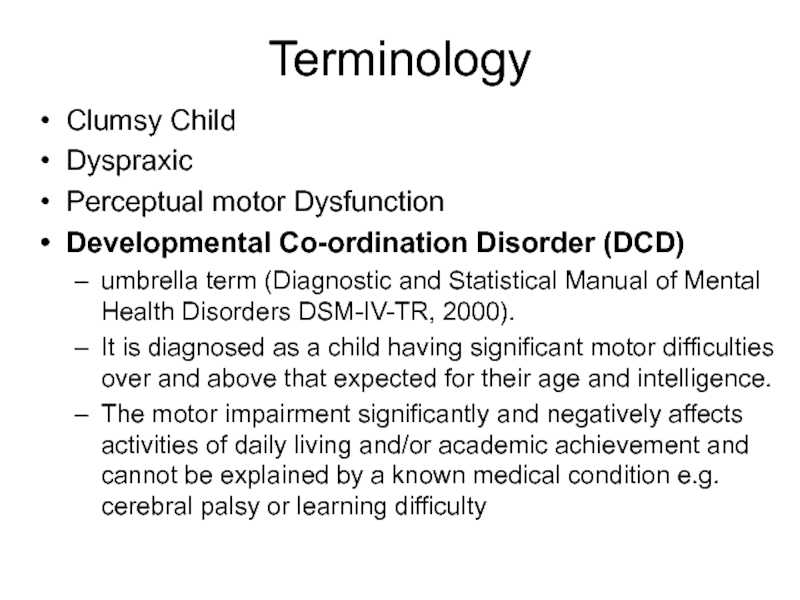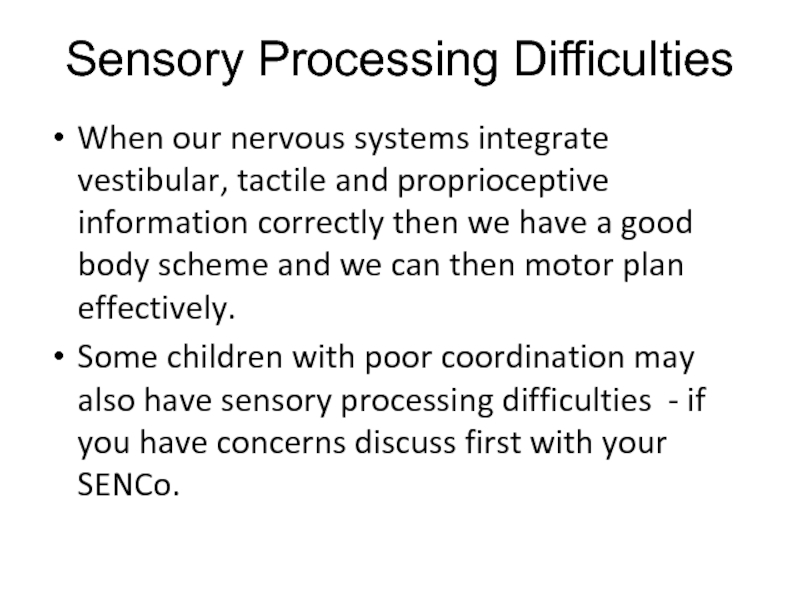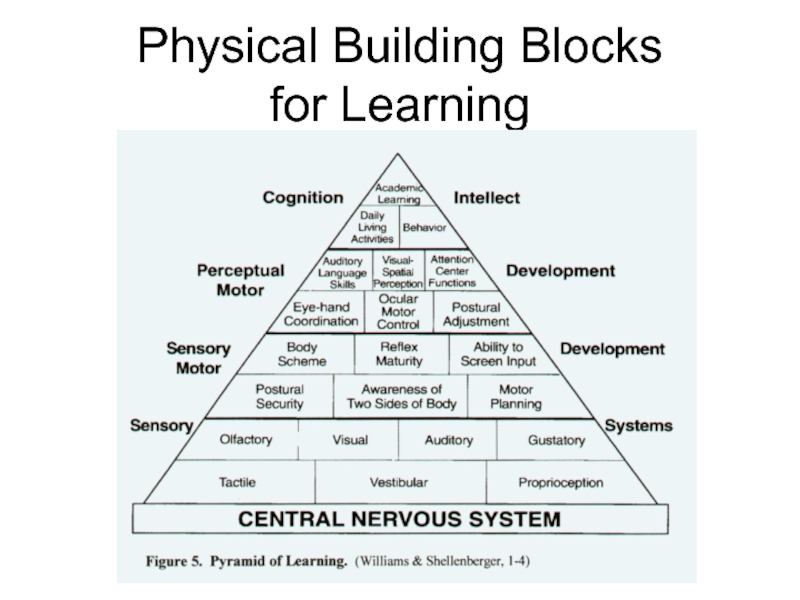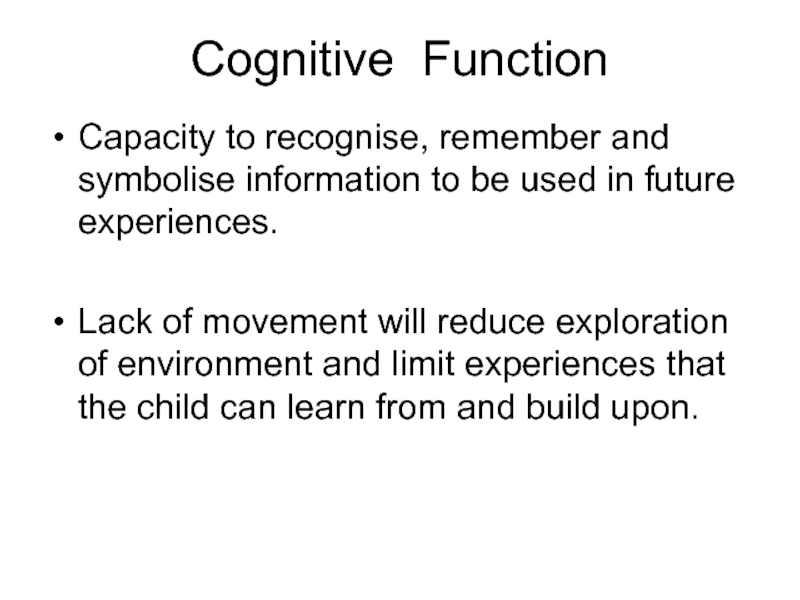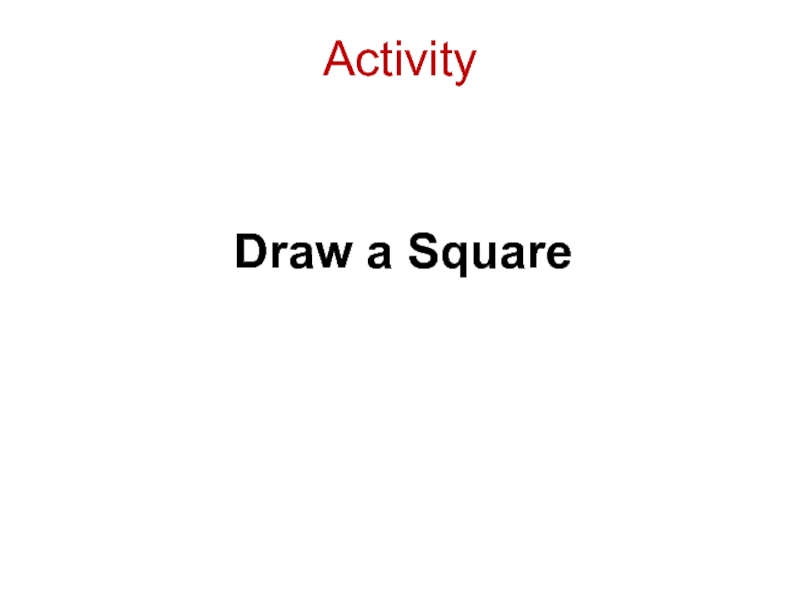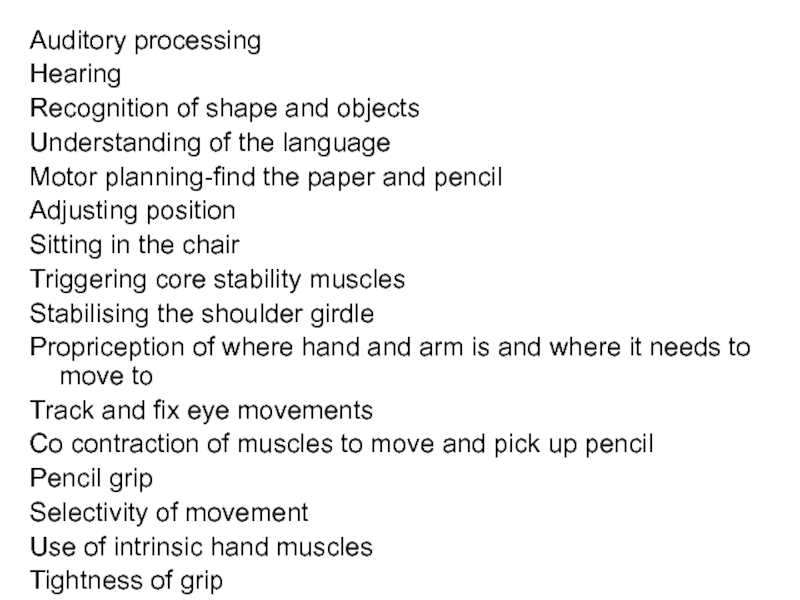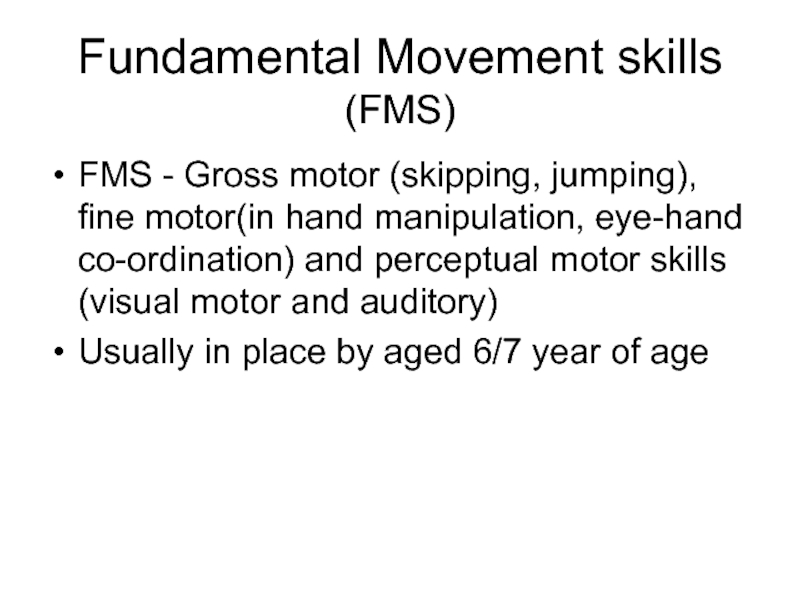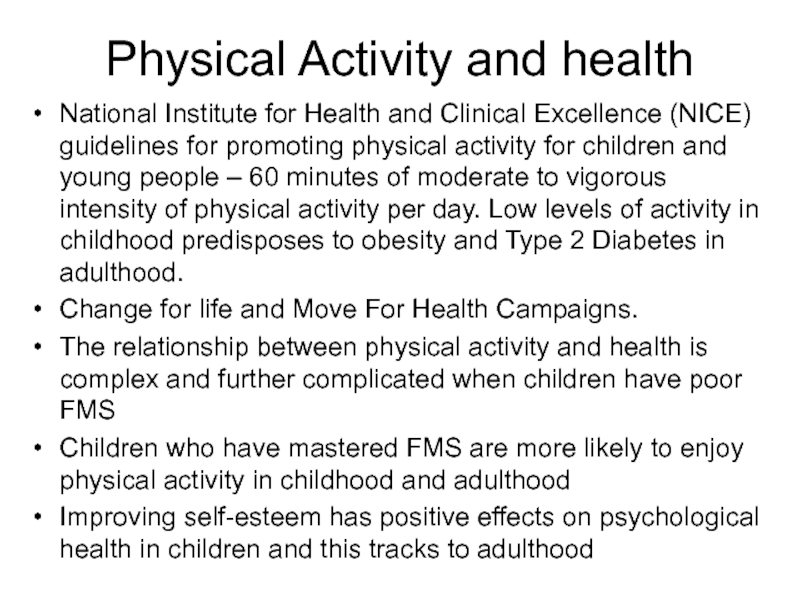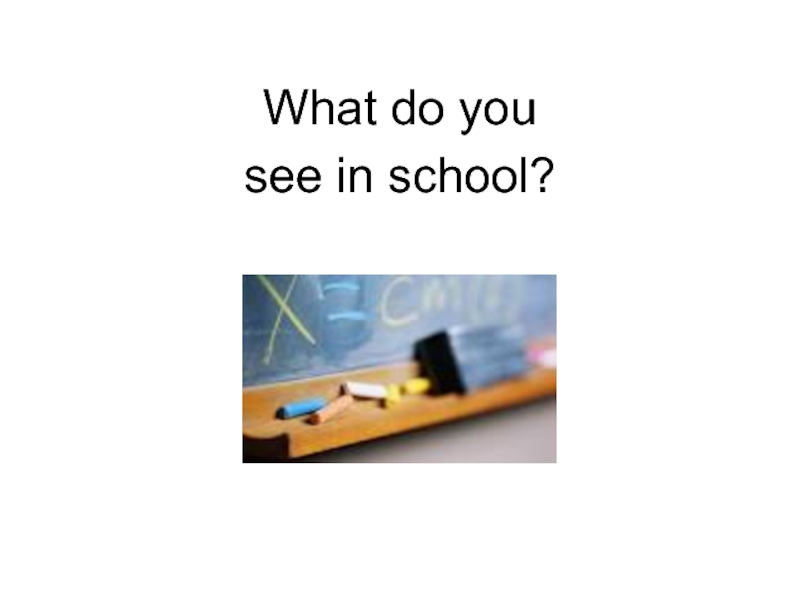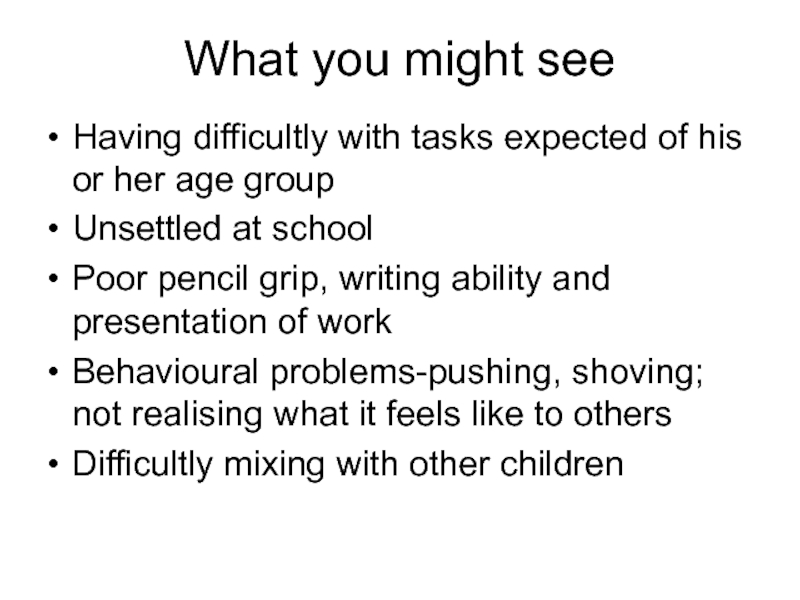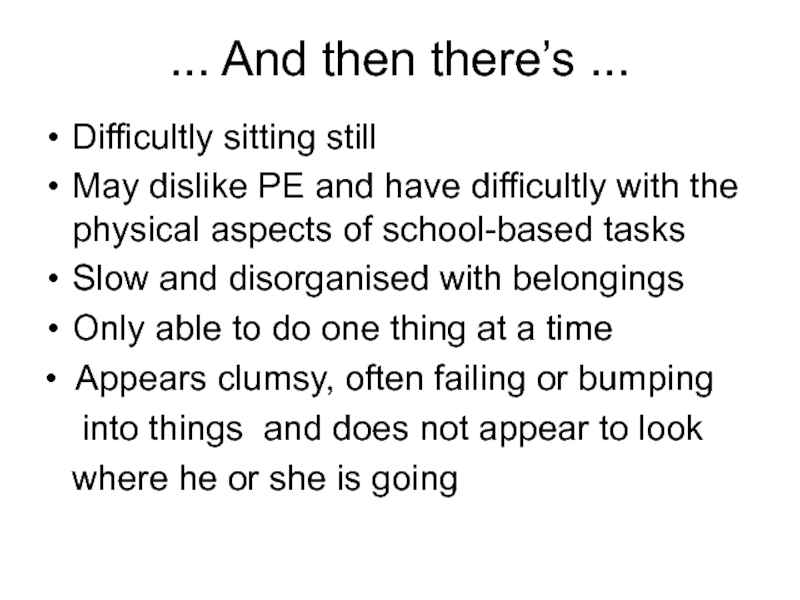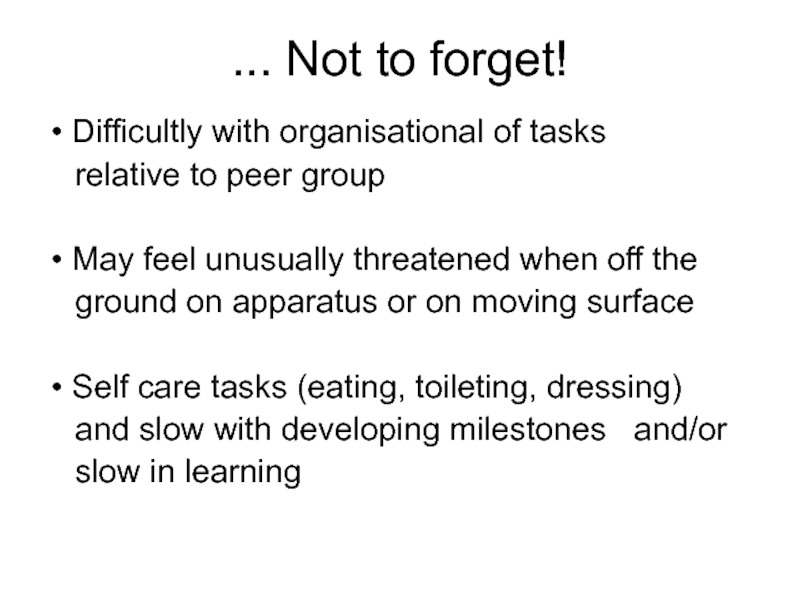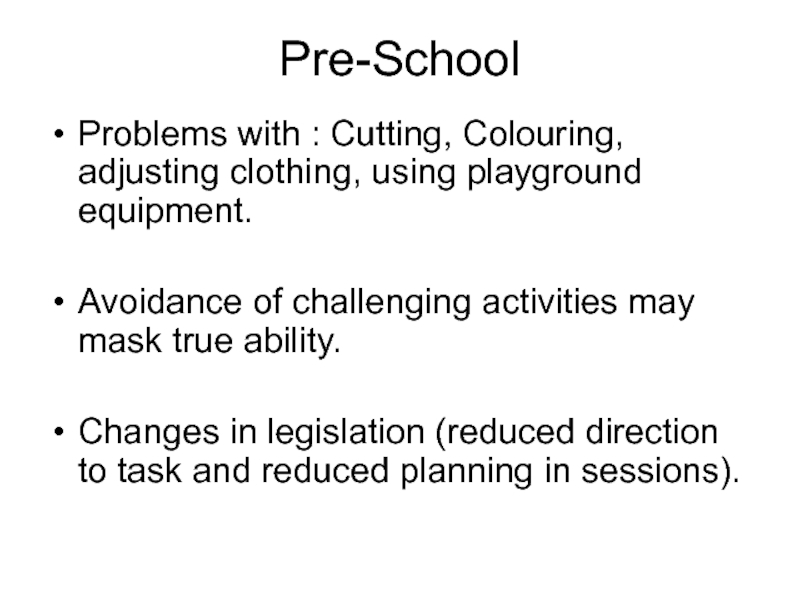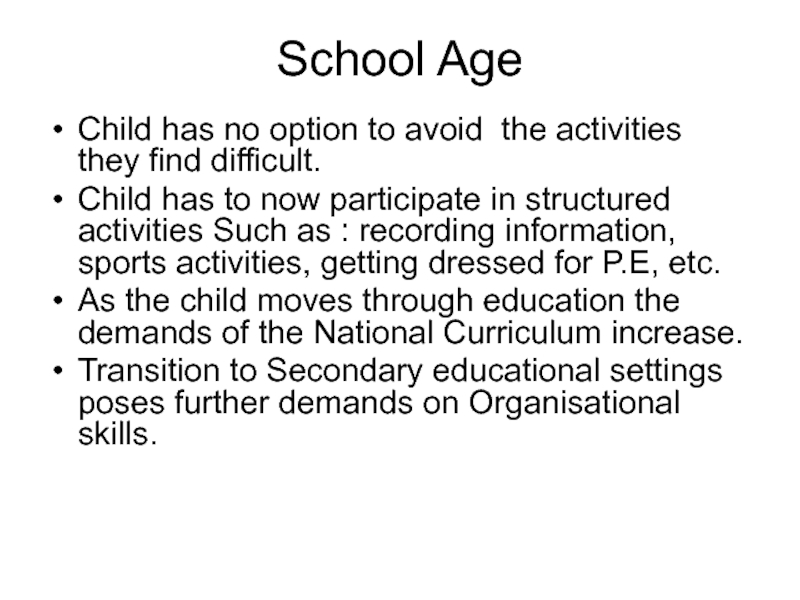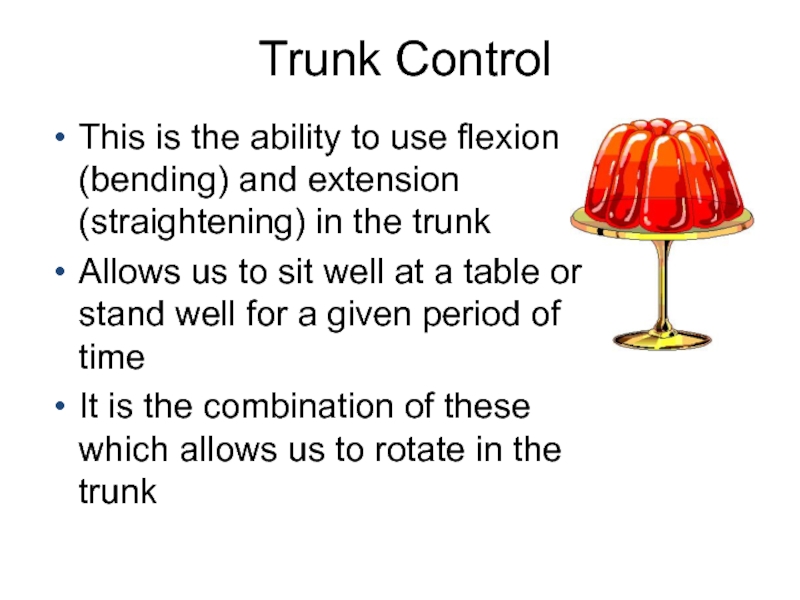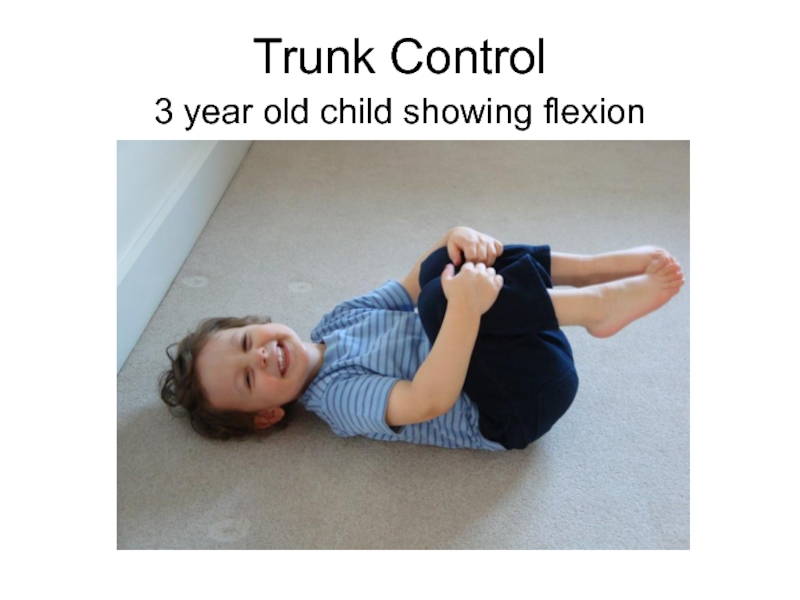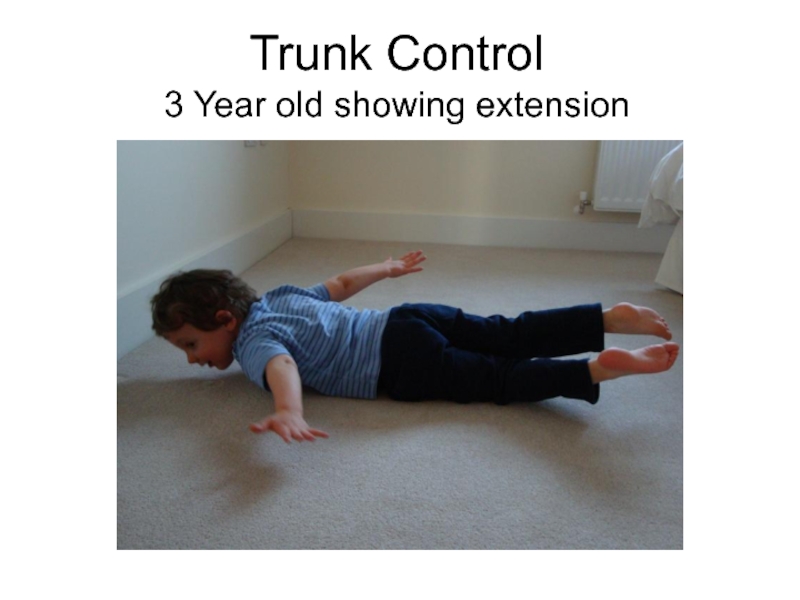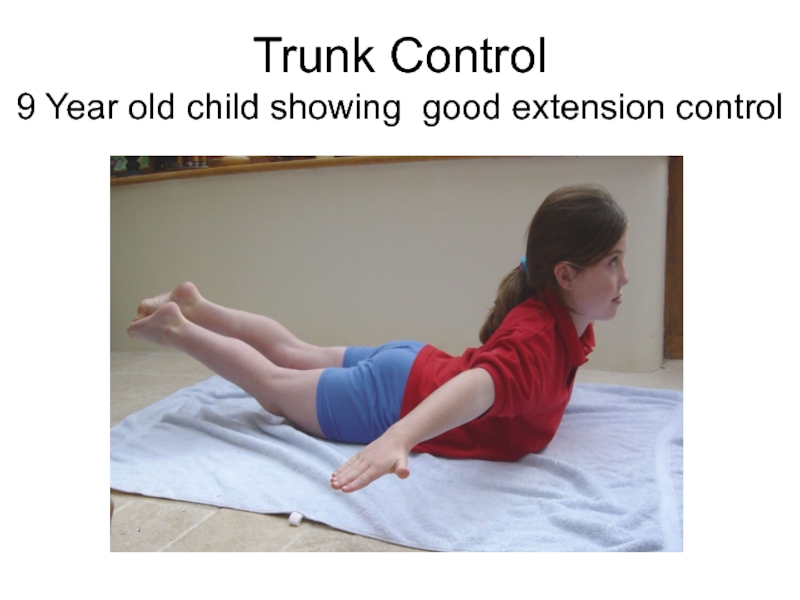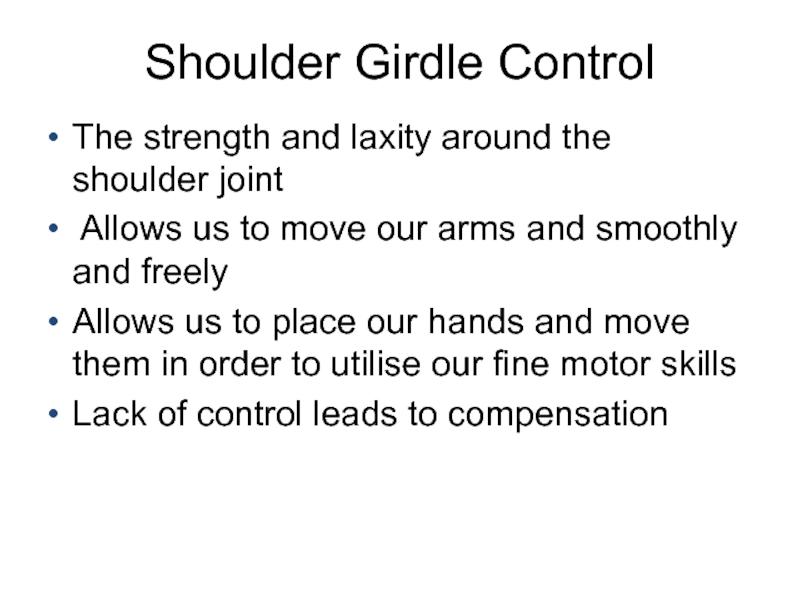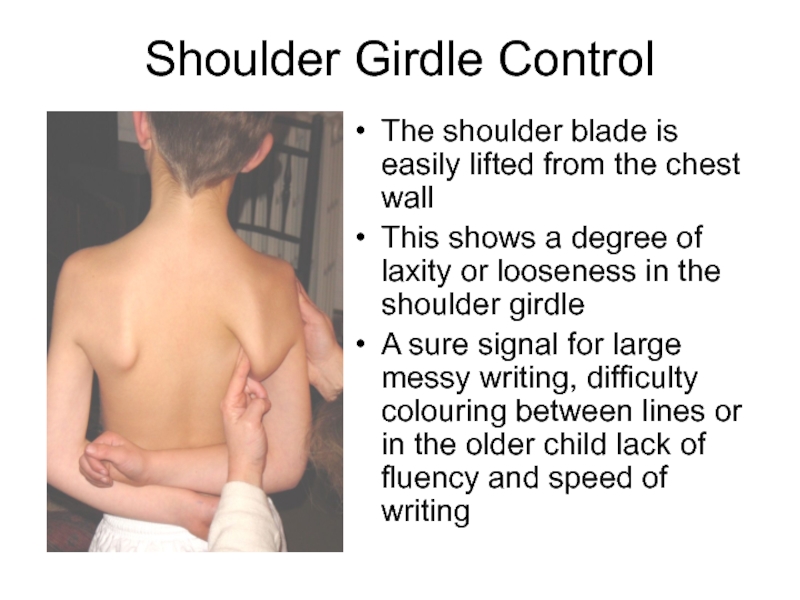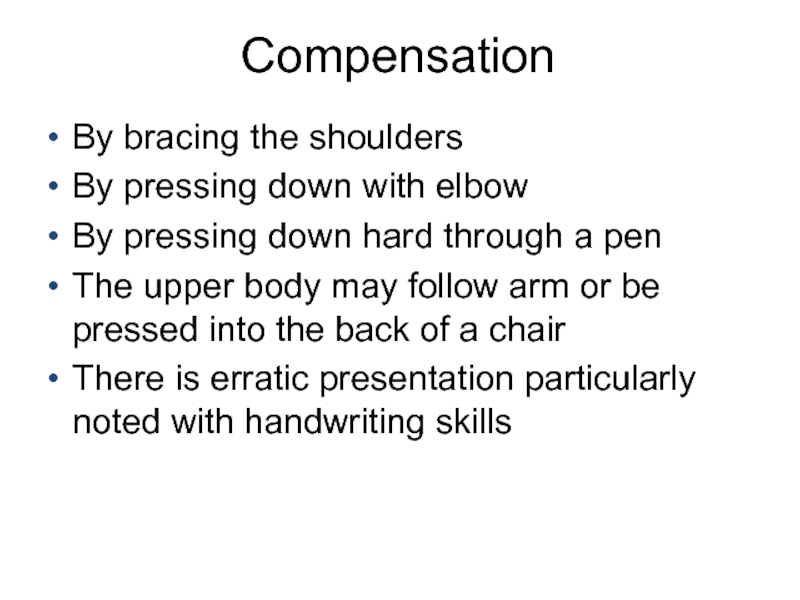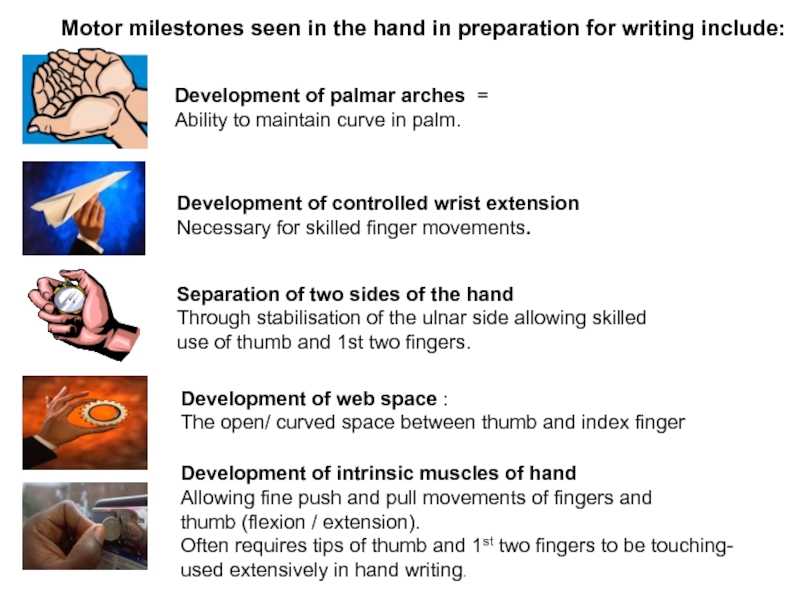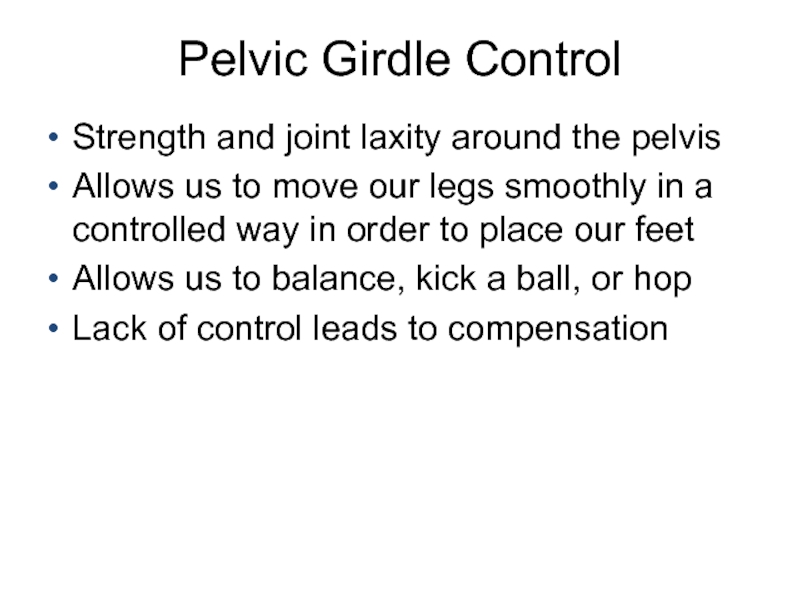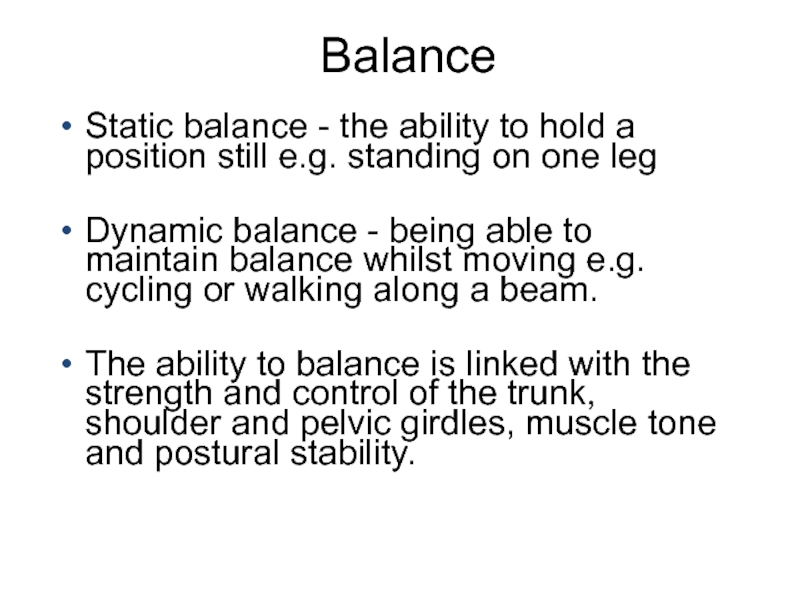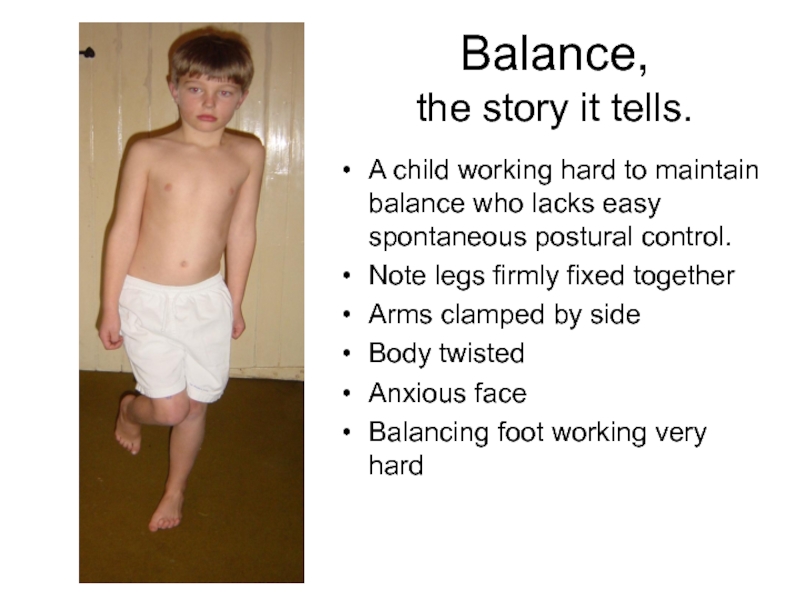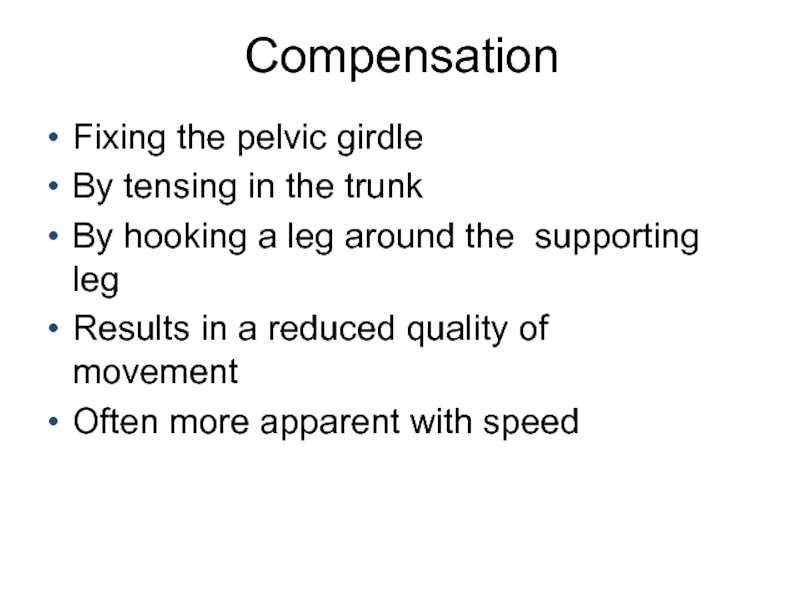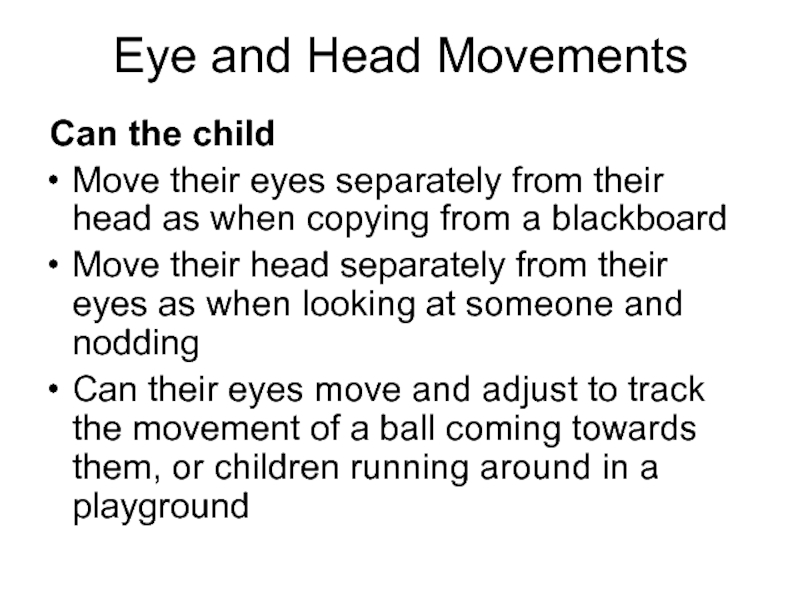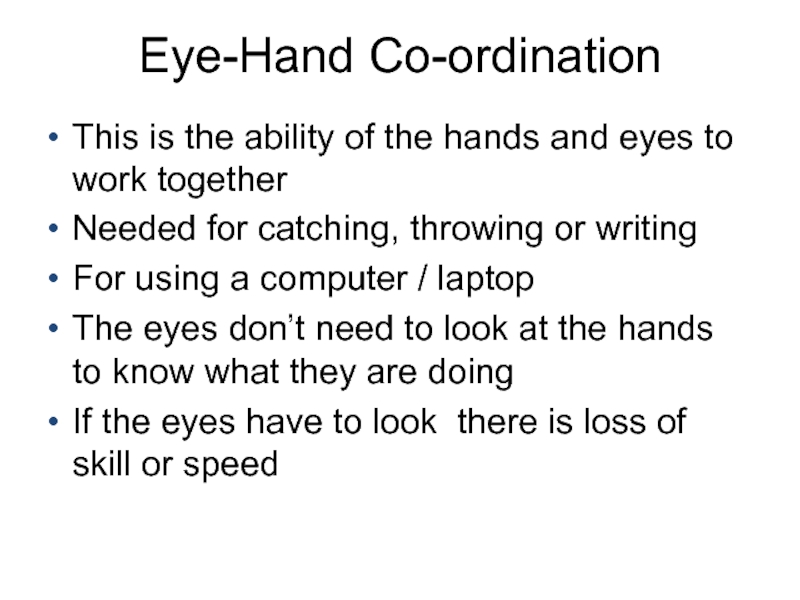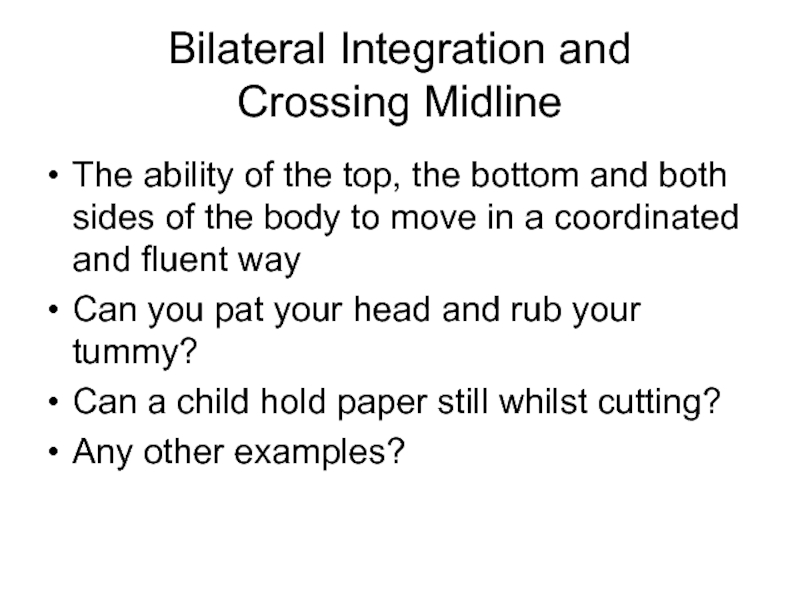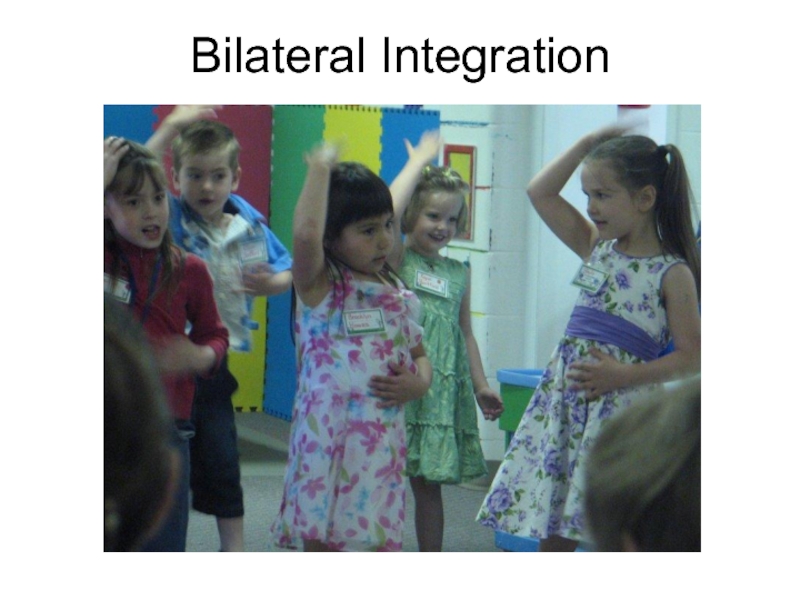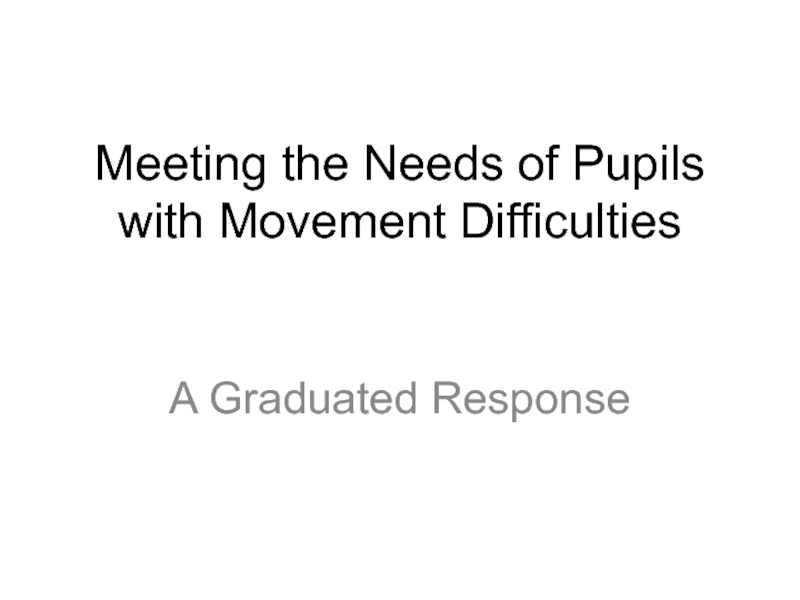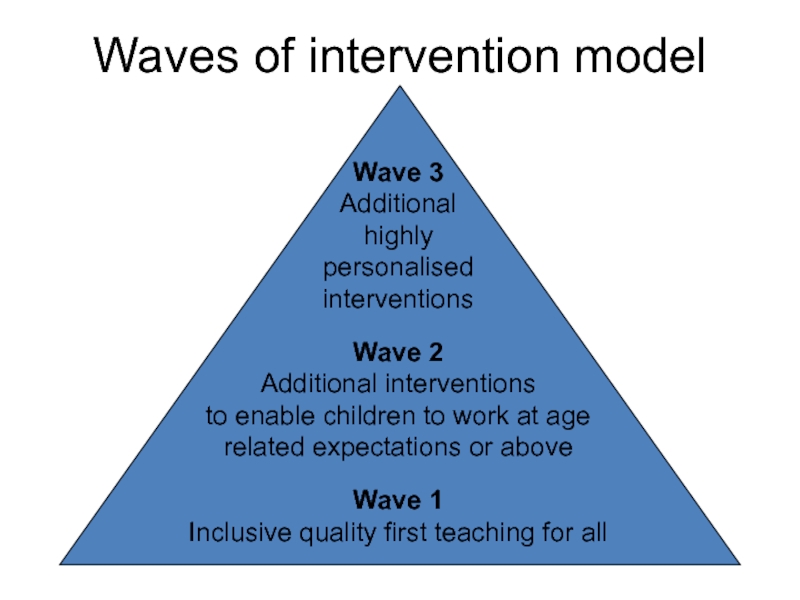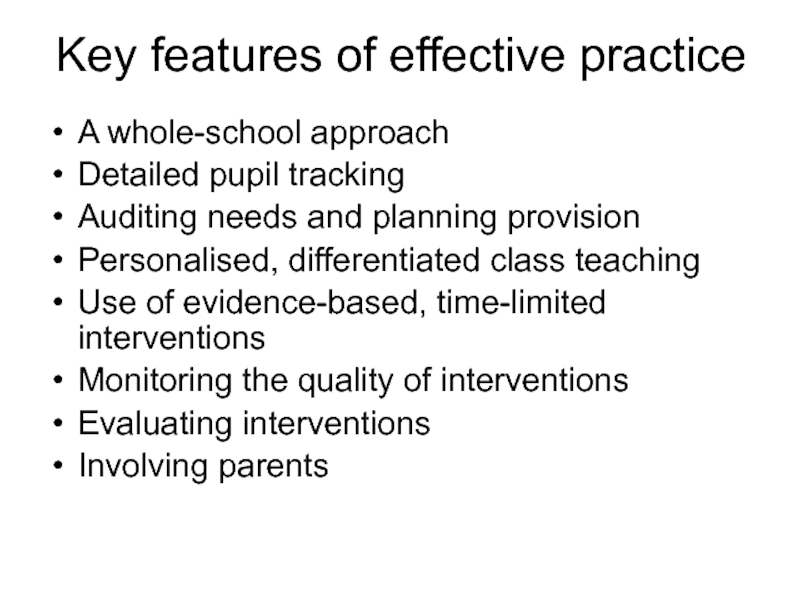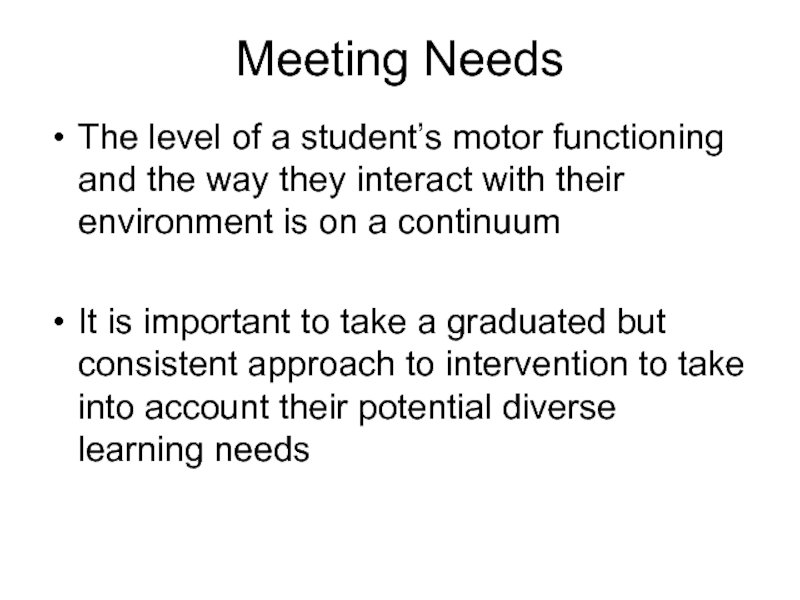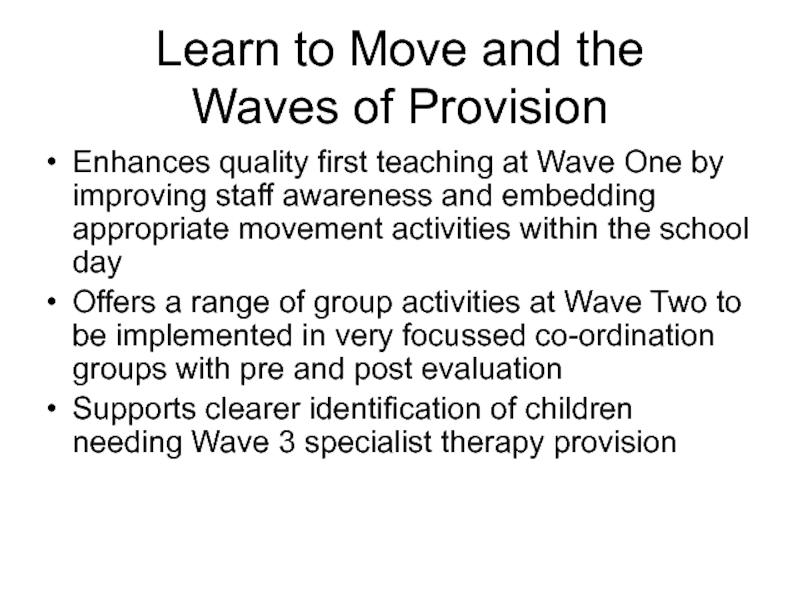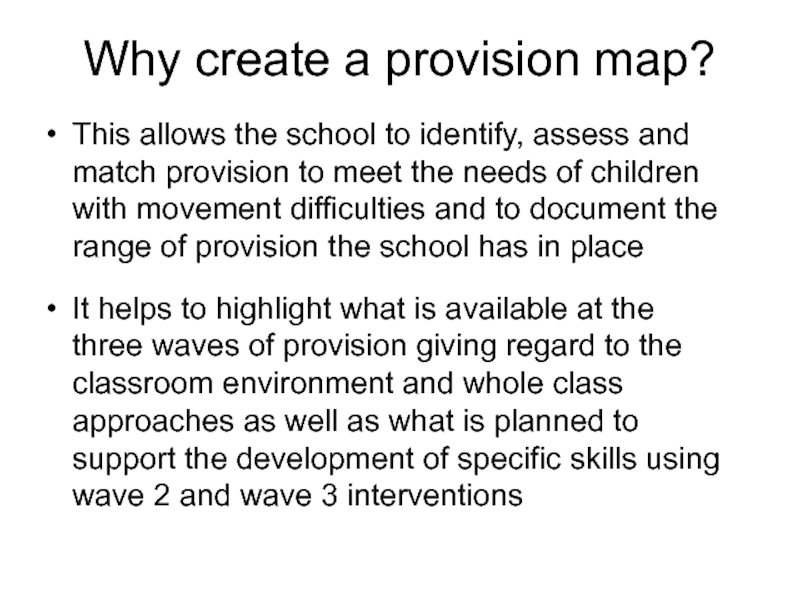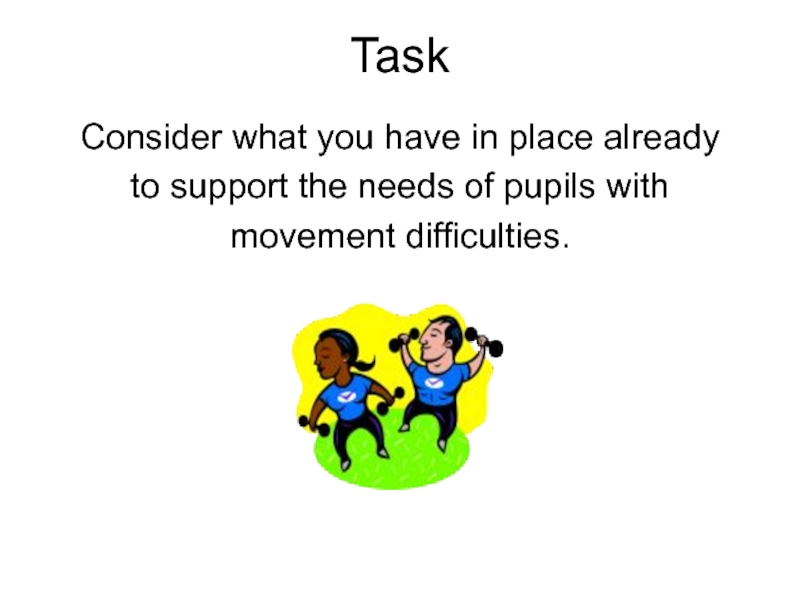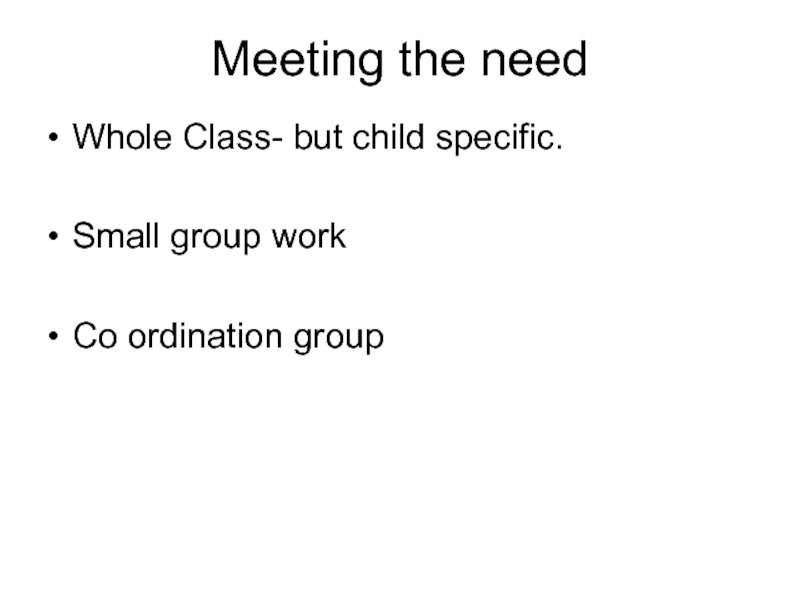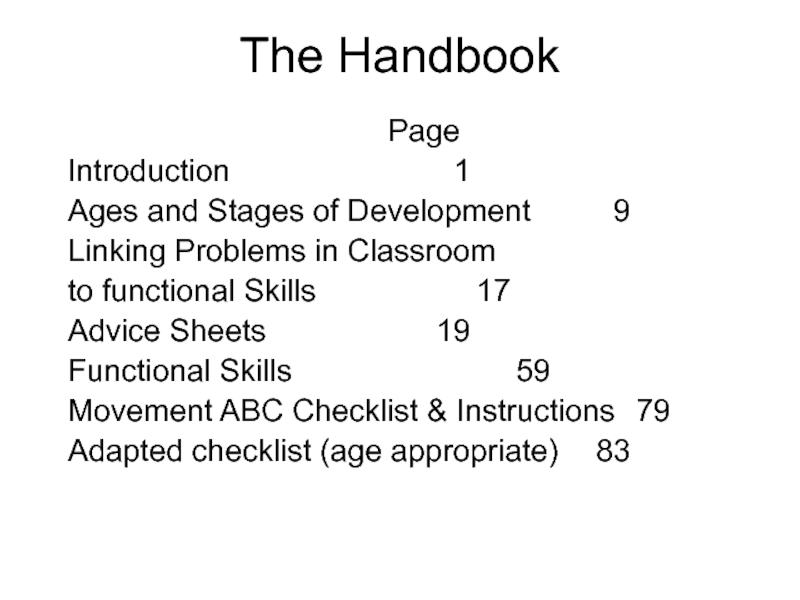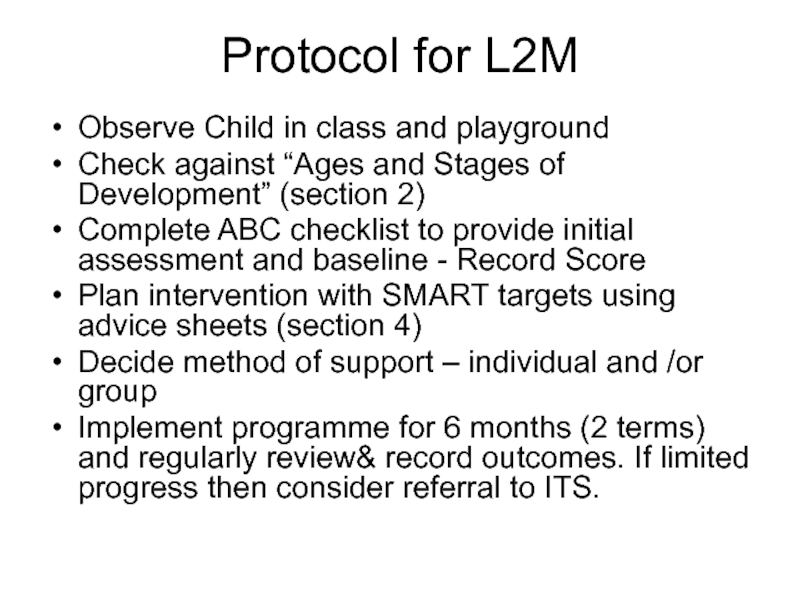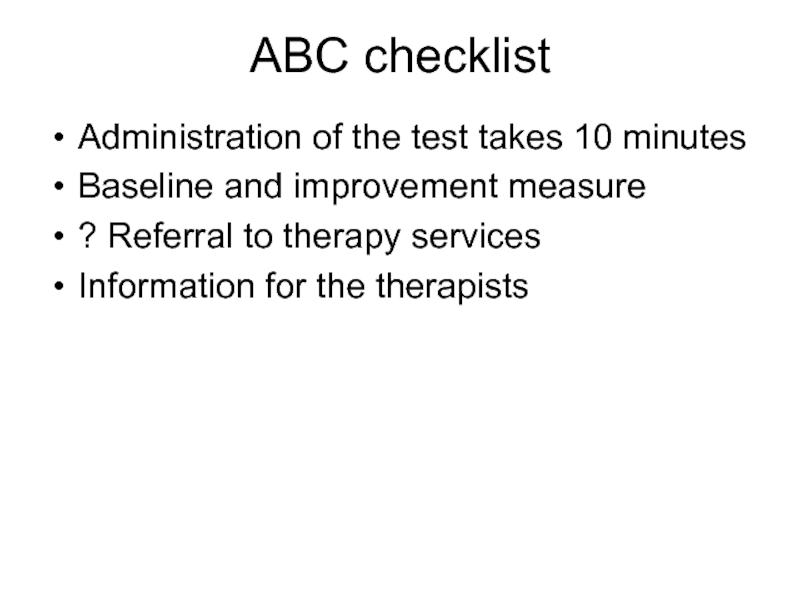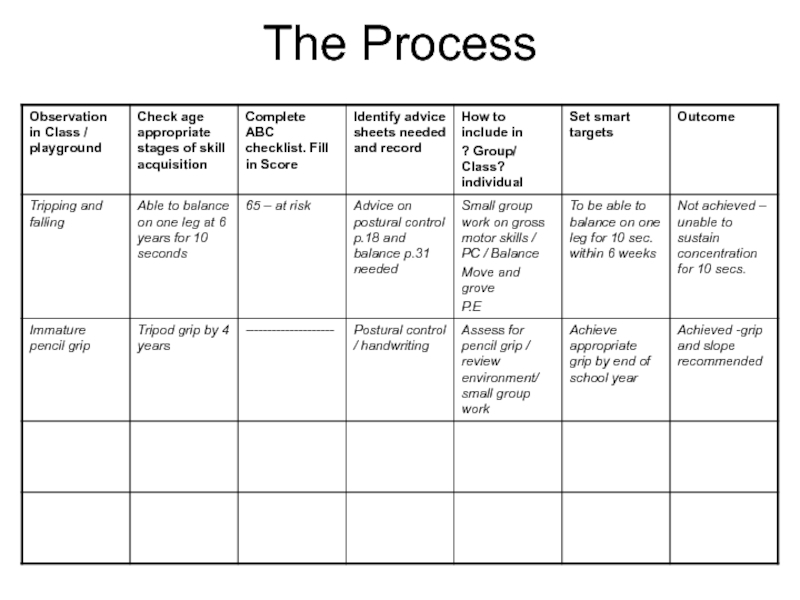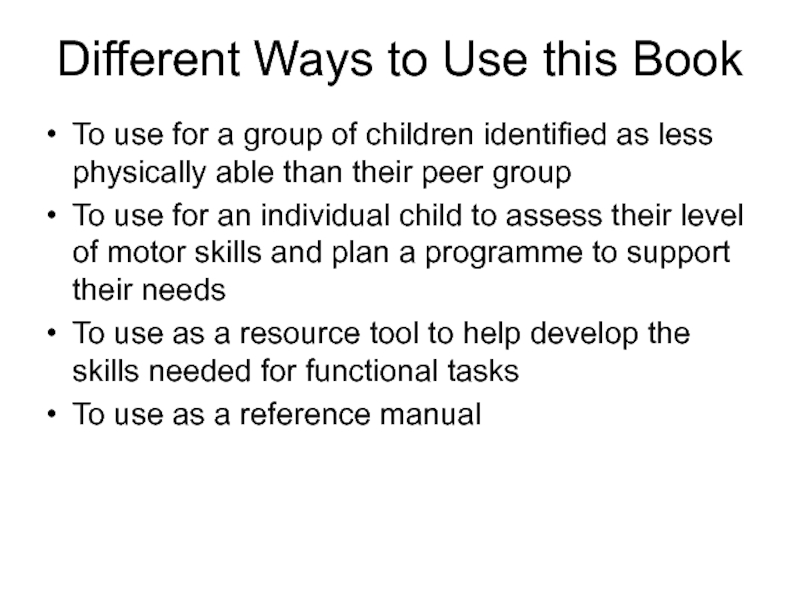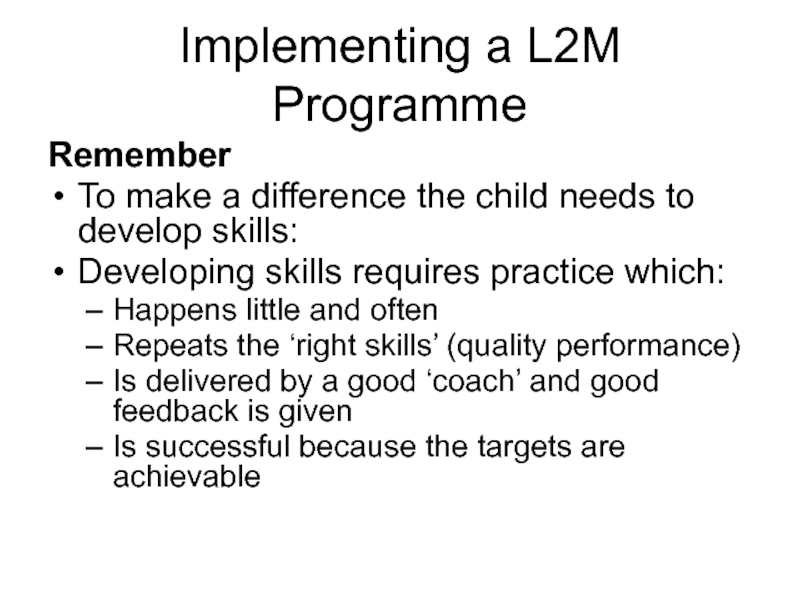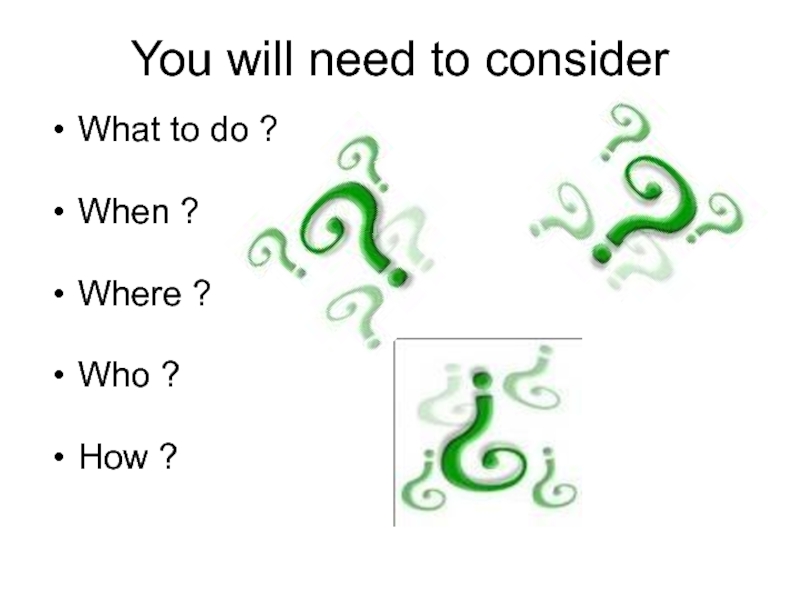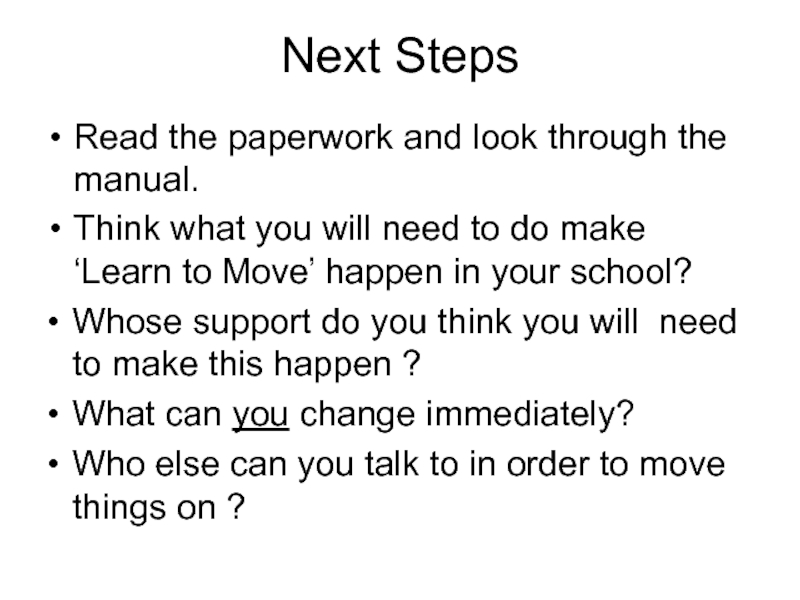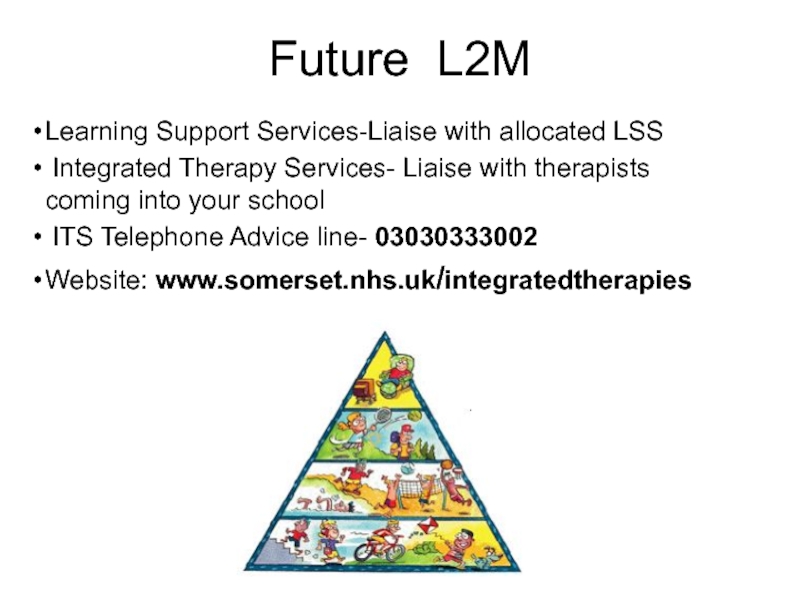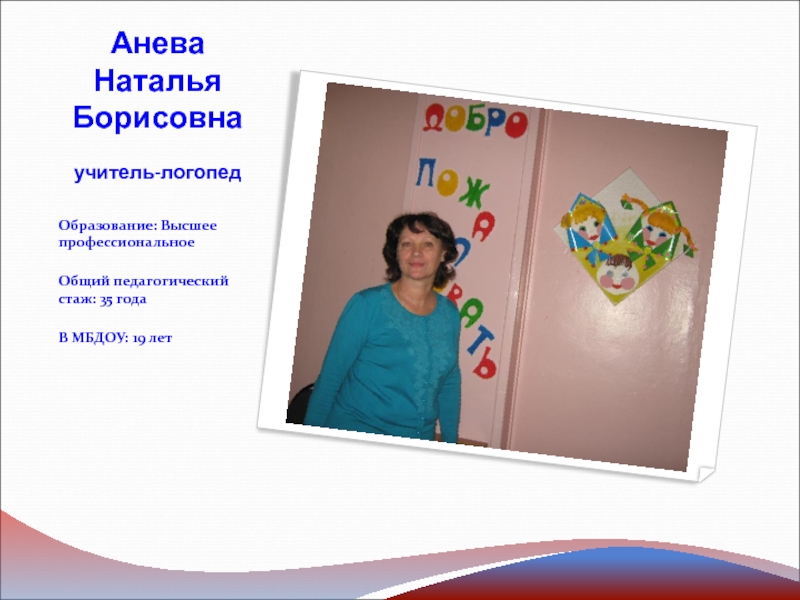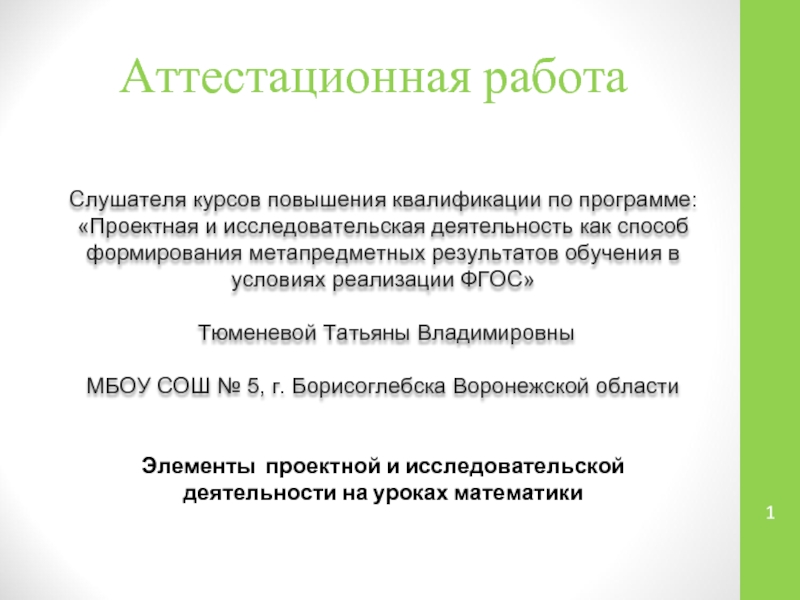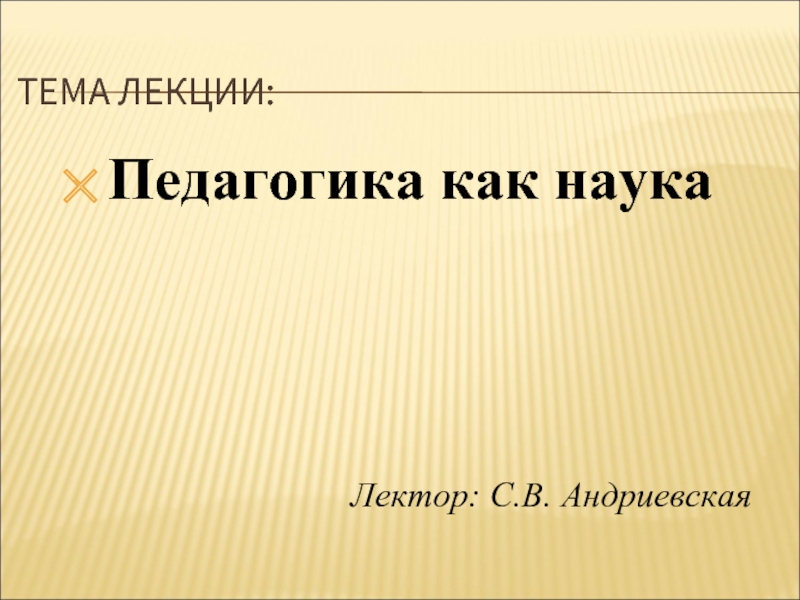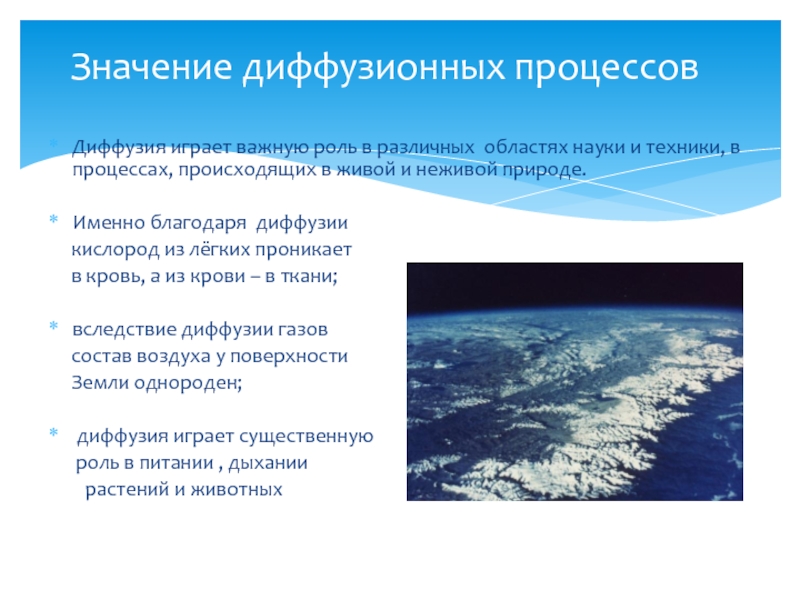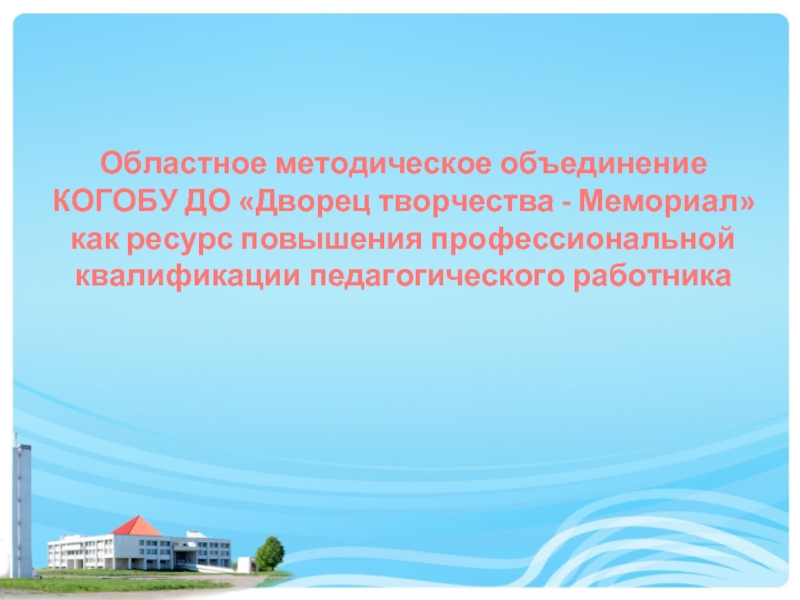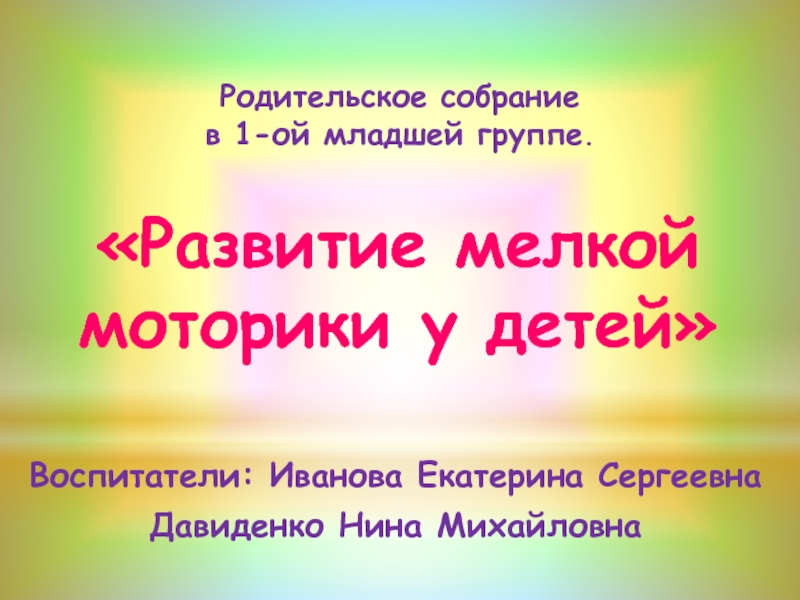- Главная
- Разное
- Дизайн
- Бизнес и предпринимательство
- Аналитика
- Образование
- Развлечения
- Красота и здоровье
- Финансы
- Государство
- Путешествия
- Спорт
- Недвижимость
- Армия
- Графика
- Культурология
- Еда и кулинария
- Лингвистика
- Английский язык
- Астрономия
- Алгебра
- Биология
- География
- Детские презентации
- Информатика
- История
- Литература
- Маркетинг
- Математика
- Медицина
- Менеджмент
- Музыка
- МХК
- Немецкий язык
- ОБЖ
- Обществознание
- Окружающий мир
- Педагогика
- Русский язык
- Технология
- Физика
- Философия
- Химия
- Шаблоны, картинки для презентаций
- Экология
- Экономика
- Юриспруденция
Learn to move. Move to learn. How to help children with co-ordination difficulties презентация
Содержание
- 2. How does being physical help children learn?
- 3. Introductory Activities Time
- 4. Development of Movement Starts in Utero –
- 5. Baby on Back Strengthening tummy
- 6. Baby on the Move Pelvic Girdle
- 7. Baby Carrier Baby Walker Baby Seat Baby door swing
- 8. Normal development Linking of touch and vision
- 9. Other Senses Proprioception The feedback from muscles,
- 10. Learning by Being Physical Physical abilities and
- 11. LIFE STYLE
- 12. Terminology Clumsy Child Dyspraxic Perceptual motor Dysfunction
- 13. Sensory Processing Difficulties When our nervous systems
- 14. Physical Building Blocks for Learning
- 15. Cognitive Function Capacity to recognise, remember and
- 16. Draw a Square Activity
- 17. Auditory processing Hearing Recognition of shape and
- 18. Fundamental Movement skills (FMS) FMS - Gross
- 19. Physical Activity and health National Institute for
- 20. What do you see in school?
- 21. What you might see Having difficultly with
- 22. ... And then there’s ... Difficultly sitting
- 23. ... Not to forget! Difficultly with
- 24. Pre-School Problems with : Cutting, Colouring, adjusting
- 25. School Age Child has no option to
- 26. Trunk Control This is the ability
- 27. Trunk Control 3 year old child showing flexion
- 28. Trunk Control 9 year old child showing good flexion control
- 29. Trunk Control 3 Year old showing extension
- 30. Trunk Control 9 Year old child showing good extension control
- 31. Shoulder Girdle Control The strength and laxity
- 32. Shoulder Girdle Control Winging of the shoulder blades
- 33. Shoulder Girdle Control The shoulder blade is
- 34. Compensation By bracing the shoulders
- 35. Development of palmar arches = Ability
- 36. Pelvic Girdle Control Strength and joint laxity
- 37. Balance Static balance - the ability to
- 38. Balance, the story it tells. A
- 39. Compensation Fixing the pelvic girdle By
- 40. Eye and Head Movements Can the
- 41. Eye-Hand Co-ordination This is the ability of
- 42. Bilateral Integration and Crossing Midline The
- 43. Bilateral Integration
- 44. Meeting the Needs of Pupils with Movement Difficulties A Graduated Response
- 45. Waves of intervention model
- 46. Key features of effective practice A whole-school
- 47. Meeting Needs The level of a
- 48. Learn to Move and the Waves
- 49. Why create a provision map? This allows
- 50. Task Consider what you have in place
- 51. Meeting the need Whole Class- but child
- 52. The Handbook Page Introduction
- 53. Protocol for L2M Observe Child in class
- 54. ABC checklist Administration of the test takes
- 55. The Process
- 56. Different Ways to Use this Book To
- 57. Implementing a L2M Programme Remember To make
- 58. You will need to consider What to
- 59. Next Steps Read the paperwork and
- 60. Future L2M Learning Support Services-Liaise with allocated
- 61. Let’s grow the crystal of good practice…
Слайд 4Development of Movement
Starts in Utero – Heartbeat, Flexion.
Sequences of movement.
Learning of
Simple to Complex – positions against gravity
Слайд 5Baby on Back
Strengthening tummy muscles
Learning to grade effort and movement against gravity
Baby on Tummy
Strengthening back
muscles (extension)
Learning to grade effort and
movement against gravity
Normal Development
Слайд 6Baby on the Move
Pelvic Girdle Stability
Shoulder Girdle Stability
Trunk Control
Postural control mechanisms
Balance reactions
Muscle strength and muscle control
Слайд 8Normal development
Linking of touch and vision and more specific responses –
Development of extension, rotation and weight shift underpin motor ability and these skills are lacking in children with movement problems.
The five senses we all know:- Smell, Touch, Hearing, Taste and Vision
Слайд 9Other Senses
Proprioception
The feedback from muscles, joints and ligaments telling you where
The Vestibular system
The balance organs in the inner ear. It provides information on how the body relates to gravity and changes your posture and movement to compensate.
Слайд 10Learning by Being Physical
Physical abilities and skills underpin all other learning.
Muscles develop because we use them
Posture, strength, balance develop with use
Awareness of own bodies, co-ordination, knowledge of space around us, time, and effort develop with experience
Skills develop by ‘USE’ and need lots of practice for pathways in brain and nervous system to establish well.
Слайд 12Terminology
Clumsy Child
Dyspraxic
Perceptual motor Dysfunction
Developmental Co-ordination Disorder (DCD)
umbrella term (Diagnostic and Statistical
It is diagnosed as a child having significant motor difficulties over and above that expected for their age and intelligence.
The motor impairment significantly and negatively affects activities of daily living and/or academic achievement and cannot be explained by a known medical condition e.g. cerebral palsy or learning difficulty
Слайд 13Sensory Processing Difficulties
When our nervous systems integrate vestibular, tactile and proprioceptive
Some children with poor coordination may also have sensory processing difficulties - if you have concerns discuss first with your SENCo.
Слайд 15Cognitive Function
Capacity to recognise, remember and symbolise information to be used
Lack of movement will reduce exploration of environment and limit experiences that the child can learn from and build upon.
Слайд 17Auditory processing
Hearing
Recognition of shape and objects
Understanding of the language
Motor planning-find the
Adjusting position
Sitting in the chair
Triggering core stability muscles
Stabilising the shoulder girdle
Propriception of where hand and arm is and where it needs to move to
Track and fix eye movements
Co contraction of muscles to move and pick up pencil
Pencil grip
Selectivity of movement
Use of intrinsic hand muscles
Tightness of grip
Manipulation of digits
Ability to cross midline
Bilateral integration
Visual motor integration.
Knowing how to draw a line
An angle and join them to make a square
Spatial awareness
Vestibular system to keep you upright.
Слайд 18Fundamental Movement skills
(FMS)
FMS - Gross motor (skipping, jumping), fine motor(in hand
Usually in place by aged 6/7 year of age
Слайд 19Physical Activity and health
National Institute for Health and Clinical Excellence (NICE)
Change for life and Move For Health Campaigns.
The relationship between physical activity and health is complex and further complicated when children have poor FMS
Children who have mastered FMS are more likely to enjoy physical activity in childhood and adulthood
Improving self-esteem has positive effects on psychological health in children and this tracks to adulthood
Слайд 21What you might see
Having difficultly with tasks expected of his or
Unsettled at school
Poor pencil grip, writing ability and presentation of work
Behavioural problems-pushing, shoving; not realising what it feels like to others
Difficultly mixing with other children
Слайд 22... And then there’s ...
Difficultly sitting still
May dislike PE and have
Slow and disorganised with belongings
Only able to do one thing at a time
Appears clumsy, often failing or bumping
into things and does not appear to look
where he or she is going
Слайд 23... Not to forget!
Difficultly with organisational of tasks
May feel unusually threatened when off the
ground on apparatus or on moving surface
Self care tasks (eating, toileting, dressing)
and slow with developing milestones and/or
slow in learning
Слайд 24Pre-School
Problems with : Cutting, Colouring, adjusting clothing, using playground equipment.
Avoidance of
Changes in legislation (reduced direction to task and reduced planning in sessions).
Слайд 25School Age
Child has no option to avoid the activities they find
Child has to now participate in structured activities Such as : recording information, sports activities, getting dressed for P.E, etc.
As the child moves through education the demands of the National Curriculum increase.
Transition to Secondary educational settings poses further demands on Organisational skills.
Слайд 26 Trunk Control
This is the ability to use flexion (bending) and
Allows us to sit well at a table or stand well for a given period of time
It is the combination of these which allows us to rotate in the trunk
Слайд 31Shoulder Girdle Control
The strength and laxity around the shoulder joint
Allows
Allows us to place our hands and move them in order to utilise our fine motor skills
Lack of control leads to compensation
Слайд 33Shoulder Girdle Control
The shoulder blade is easily lifted from the chest
This shows a degree of laxity or looseness in the shoulder girdle
A sure signal for large messy writing, difficulty colouring between lines or in the older child lack of fluency and speed of writing
Слайд 34Compensation
By bracing the shoulders
By pressing down with elbow
By pressing
The upper body may follow arm or be pressed into the back of a chair
There is erratic presentation particularly noted with handwriting skills
Слайд 35Development of palmar arches =
Ability to maintain curve in palm.
Development
Necessary for skilled finger movements.
Separation of two sides of the hand
Through stabilisation of the ulnar side allowing skilled
use of thumb and 1st two fingers.
Development of web space :
The open/ curved space between thumb and index finger
Development of intrinsic muscles of hand
Allowing fine push and pull movements of fingers and
thumb (flexion / extension).
Often requires tips of thumb and 1st two fingers to be touching- used extensively in hand writing.
Motor milestones seen in the hand in preparation for writing include:
Слайд 36Pelvic Girdle Control
Strength and joint laxity around the pelvis
Allows us to
Allows us to balance, kick a ball, or hop
Lack of control leads to compensation
Слайд 37Balance
Static balance - the ability to hold a position still e.g.
Dynamic balance - being able to maintain balance whilst moving e.g. cycling or walking along a beam.
The ability to balance is linked with the strength and control of the trunk, shoulder and pelvic girdles, muscle tone and postural stability.
Слайд 38Balance,
the story it tells.
A child working hard to maintain balance
Note legs firmly fixed together
Arms clamped by side
Body twisted
Anxious face
Balancing foot working very hard
Слайд 39Compensation
Fixing the pelvic girdle
By tensing in the trunk
By hooking a
Results in a reduced quality of movement
Often more apparent with speed
Слайд 40Eye and Head Movements
Can the child
Move their eyes separately
Move their head separately from their eyes as when looking at someone and nodding
Can their eyes move and adjust to track the movement of a ball coming towards them, or children running around in a playground
Слайд 41Eye-Hand Co-ordination
This is the ability of the hands and eyes to
Needed for catching, throwing or writing
For using a computer / laptop
The eyes don’t need to look at the hands to know what they are doing
If the eyes have to look there is loss of skill or speed
Слайд 42Bilateral Integration and
Crossing Midline
The ability of the top, the bottom
Can you pat your head and rub your tummy?
Can a child hold paper still whilst cutting?
Any other examples?
Слайд 46Key features of effective practice
A whole-school approach
Detailed pupil tracking
Auditing needs
Personalised, differentiated class teaching
Use of evidence-based, time-limited interventions
Monitoring the quality of interventions
Evaluating interventions
Involving parents
Слайд 47Meeting Needs
The level of a student’s motor functioning and the
It is important to take a graduated but consistent approach to intervention to take into account their potential diverse learning needs
Слайд 48Learn to Move and the
Waves of Provision
Enhances quality first teaching
Offers a range of group activities at Wave Two to be implemented in very focussed co-ordination groups with pre and post evaluation
Supports clearer identification of children needing Wave 3 specialist therapy provision
Слайд 49Why create a provision map?
This allows the school to identify, assess
It helps to highlight what is available at the three waves of provision giving regard to the classroom environment and whole class approaches as well as what is planned to support the development of specific skills using wave 2 and wave 3 interventions
Слайд 50Task
Consider what you have in place already
to support the needs
movement difficulties.
Слайд 52The Handbook
Page
Introduction 1
Ages and Stages of Development
Linking Problems in Classroom
to functional Skills 17
Advice Sheets 19
Functional Skills 59
Movement ABC Checklist & Instructions 79
Adapted checklist (age appropriate) 83
Слайд 53Protocol for L2M
Observe Child in class and playground
Check against “Ages and
Complete ABC checklist to provide initial assessment and baseline - Record Score
Plan intervention with SMART targets using advice sheets (section 4)
Decide method of support – individual and /or group
Implement programme for 6 months (2 terms) and regularly review& record outcomes. If limited progress then consider referral to ITS.
Слайд 54ABC checklist
Administration of the test takes 10 minutes
Baseline and improvement measure
? Referral to therapy services
Information for the therapists
Слайд 56Different Ways to Use this Book
To use for a group of
To use for an individual child to assess their level of motor skills and plan a programme to support their needs
To use as a resource tool to help develop the skills needed for functional tasks
To use as a reference manual
Слайд 57Implementing a L2M Programme
Remember
To make a difference the child needs to
Developing skills requires practice which:
Happens little and often
Repeats the ‘right skills’ (quality performance)
Is delivered by a good ‘coach’ and good feedback is given
Is successful because the targets are achievable
Слайд 59Next Steps
Read the paperwork and look through the manual.
Think what
Whose support do you think you will need to make this happen ?
What can you change immediately?
Who else can you talk to in order to move things on ?
Слайд 60Future L2M
Learning Support Services-Liaise with allocated LSS
Integrated Therapy Services- Liaise
ITS Telephone Advice line- 03030333002
Website: www.somerset.nhs.uk/integratedtherapies
